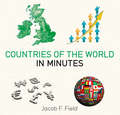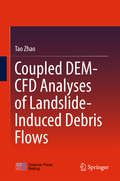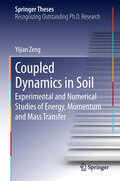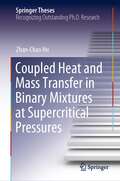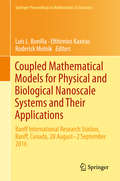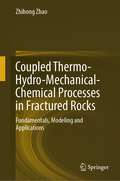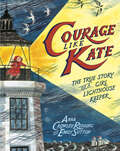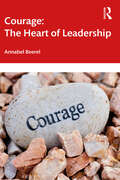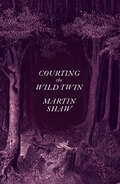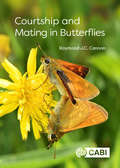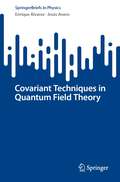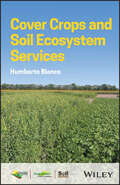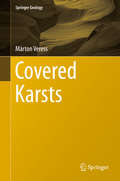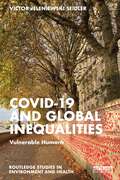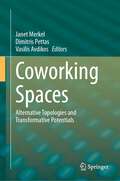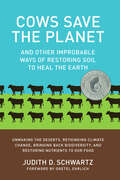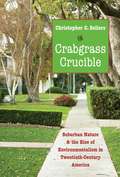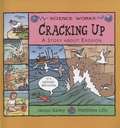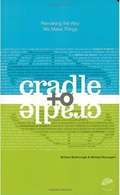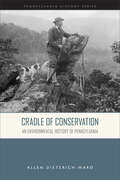- Table View
- List View
Countries of the World in Minutes (In Minutes)
by Jacob F. FieldFor each of the 195 officially recognized countries of the world, a mini essay clearly and concisely explains its key history, characteristics, and social and political structures. Alongside, an outline map shows each country's global location, main geographic features, and capital city, while a table of essential data details its population, political system, languages, major religions, currency, gross domestic product, main industries, and much more.
Coupled DEM-CFD Analyses of Landslide-Induced Debris Flows (Springer Tracts in Civil Engineering)
by Tao ZhaoThis book reflects the latest research results in computer modelling of landslide-induced debris flows. The book establishes an understanding of the initiation and propagation mechanisms of landslides by means of numerical simulations, so that mitigation strategies to reduce the long-term losses from landslide hazards can be devised. In this context, the book employs the Discrete Element Method (DEM) and Computational Fluid Dynamics (CFD) to investigate the mechanical and hydraulic behaviour of granular materials involved in landslides - an approach that yields meaningful insights into the flow mechanisms, concerning e. g. the mobilization of sediments, the generation and dissipation of excess pore water pressures, and the evolution of effective stresses. As such, the book provides valuable information, useful methods and robust numerical tools that can be successfully applied in the field of debris flow research.
Coupled Dynamics in Soil: Experimental and Numerical Studies of Energy, Momentum and Mass Transfer (Springer Theses)
by Yijian ZengIn arid and semi-arid areas, the main contributions to land surface processes are precipitation, surface evaporation and surface energy balancing. In the close-to-surface layer and root-zone layer, vapor flux is the dominant flux controlling these processes - process which, in turn, influence the local climate pattern and the local ecosystem. The work reported in this thesis attempts to understand how the soil airflow affects the vapor transport during evaporation processes, by using a two-phase heat and mass transfer model. The necessity of including the airflow mechanism in land surface process studies is discussed and highlighted.
Coupled Heat and Mass Transfer in Binary Mixtures at Supercritical Pressures (Springer Theses)
by Zhan-Chao HuSupercritical pressure fluids have been exploited in many engineering fields, where binary mixtures are frequently encountered. This book focuses on the coupled heat and mass transfer in them, where the coupling comes from cross-diffusion effects (i.e., Soret and Dufour effects) and temperature-dependent boundary reactions. Under this configuration, three main topics are discussed: relaxation and diffusion problems, hydrodynamic stability, and convective heat and mass transfer. This book reports a series of new phenomena, novel mechanisms, and an innovative engineering design in hydrodynamics and transport phenomena of binary mixtures at supercritical pressures. This book covers not only current research progress but also basic knowledge and background. It is very friendly to readers new to this field, especially graduate students without a deep theoretical background.
Coupled Mathematical Models for Physical and Biological Nanoscale Systems and Their Applications: Banff International Research Station, Banff, Canada, 28 August - 2 September 2016 (Springer Proceedings in Mathematics & Statistics #232)
by Roderick Melnik Luis L. Bonilla Efthimios KaxirasThis volume gathers selected contributions from the participants of the Banff International Research Station (BIRS) workshop Coupled Mathematical Models for Physical and Biological Nanoscale Systems and their Applications, who explore various aspects of the analysis, modeling and applications of nanoscale systems, with a particular focus on low dimensional nanostructures and coupled mathematical models for their description. Due to the vastness, novelty and complexity of the interfaces between mathematical modeling and nanoscience and nanotechnology, many important areas in these disciplines remain largely unexplored. In their efforts to move forward, multidisciplinary research communities have come to a clear understanding that, along with experimental techniques, mathematical modeling and analysis have become crucial to the study, development and application of systems at the nanoscale. The conference, held at BIRS in autumn 2016, brought together experts from three different communities working in fields where coupled mathematical models for nanoscale and biosystems are especially relevant: mathematicians, physicists (both theorists and experimentalists), and computational scientists, including those dealing with biological nanostructures. Its objectives: summarize the state-of-the-art; identify and prioritize critical problems of major importance that require solutions; analyze existing methodologies; and explore promising approaches to addressing the challenges identified. The contributions offer up-to-date introductions to a range of topics in nano and biosystems, identify important challenges, assess current methodologies and explore promising approaches. As such, this book will benefit researchers in applied mathematics, as well as physicists and biologists interested in coupled mathematical models and their analysis for physical and biological nanoscale systems that concern applications in biotechnology and medicine, quantum information processing and optoelectronics.
Coupled Thermo-Hydro-Mechanical Processes in Fractured Rock Masses: Discrete Element Modeling and Engineering Applications
by Fengshou Zhang Branko Damjanac Jason FurtneyThe subject of thermo-hydro-mechanical coupled processes in fractured rock masses has close relevance to energy-related deep earth engineering activities, such as enhanced geothermal systems, geological disposal of radioactive waste, sequestration of CO2, long-term disposal of waste water and recovery of hydrocarbons from unconventional reservoirs. Despite great efforts by engineers and researchers, comprehensive understanding of the thermo-hydro-mechanical coupled processes in fractured rock mass remains a great challenge. The discrete element method (DEM), originally developed by Dr. Peter Cundall, has become widely used for the modeling of a rock mass, including its deformation, damage, fracturing and stability. DEM modeling of the coupled thermo-hydro-mechanical processes in fractured rock masses can provide some unique insights, to say the least, for better understanding of those complex issues.The authors of this book have participated in various projects involving DEM modeling of coupled thermo-hydro-mechanical processes during treatment of a rock mass by fluid injection and/or extraction and have provided consulting services to some of the largest oil-and-gas companies in the world. The breadth and depth of our engineering expertise are reflected by its successful applications in the major unconventional plays in the world, including Permian, Marcellus, Bakken, Eagle Ford, Horn River, Chicontepec, Sichuan, Ordos and many more. The unique combination of the state-of-the-art numerical modeling techniques with state-of-the-practice engineering applications makes the presented material relevant and valuable for engineering practice. We believe that it is beneficial to share the advances on this subject and promote some further development.
Coupled Thermo-Hydro-Mechanical-Chemical Processes in Fractured Rocks: Fundamentals, Modeling and Applications
by Zhihong ZhaoThis book presents the coupled Thermo-Hydro-Mechanical-Chemical (THMC) processes in fractured rocks at varying scales from single fractures to fracture networks. It also discussed the implication and potential application of the advanced understanding of coupled THMC processes in fractured rocks for geotechnical and geo-energy engineering.
Courage Like Kate: The True Story of a Girl Lighthouse Keeper
by Anna Crowley ReddingAn inspiring and beautifully illustrated picture book biography based on the life of Kate Moore, a twelve-year-old lighthouse keeper in the 19th century who saved the lives of twenty-three sailors.With an evocative text and stunning illustrations, travel back to the stormy, rocky shores of 19th century Connecticut and meet an unforgettable heroine-- at a time when girls were considered anything but. Fayerweather Island had seen blustery blizzards and rip-roaring tides, but it had never seen a pint-sized hurricane until Kate Moore claimed that tiny island as her own. Little Kate was supposed to be the lighthouse keeper&’s daughter, but she thought of herself as Papa&’s assistant. The thirty-three spiraling lighthouse stairs finally took a toll on Papa&’s body, and so twelve-year-old Kate stepped up. Over the years, she kept the flame lit to guide ships to safety, listened for cries for help, and, time and again, pulled men to safety—twenty-three of them in all. At the age of forty-seven, Kate received word—she had been named the official lighthouse keeper of Fayerweather Island. This girl-power picture book introduces a small heroine, who, with her can-do attitude and incredible spirit, is sure to inspire.
Courage: The Heart of Leadership
by Annabel BeerelCourage lies at the heart of leadership. Leaders need courage to make wise decisions, not self-interested ones. They need to be able to set aside their egos, to feel vulnerable, to face challenges, yet remain principled and hold the course. This book presents many suggestions on how to make a real difference in organizations, and explains how one can develop the courage to be an effective leader, step by step.The book is designed to give leaders the self-awareness and the tools to overcome the obstacles that prevent us from leading effectively. Leadership requires working through the systemic barriers that serve as forcefields pulling and pushing us in various directions. Drawing on interviews with over 20 organizational leaders in a variety of industries, the book helps leaders to address key areas that are rarely discussed: the personal baggage attached to authority, self-esteem and self-differentiation, ego management, and the terror of the group. It highlights – with examples – how fear impairs our ability to make good decisions, and how our tendency to reactivity and the quick fix vitiates our attempts at being courageous. The hallmark of courage is the ability to have courageous conversations that invite transformation.The book is ideal reading for organizational leaders who are seeking ways to break through some of the personal and systemic barriers to leading with purpose in a way that makes a real difference.
Courting the Wild Twin
by Martin ShawMaster mythologist Martin Shaw uses timeless story-wisdom to examine our broken relationship with the world There is an old legend that says we each have a wild, curious twin that was thrown out the window the night we were born, taking much of our vitality with them. If there was something we were meant to do with our few, brief years on Earth, we can be sure that the wild twin is holding the key. In Courting the Wild Twin, Dr. Martin Shaw invites us to seek out our wild twin––a metaphor for the part of ourselves that we generally shun or ignore to conform to societal norms––to invite them back into our consciousness, for they have something important to tell us. He challenges us to examine our broken relationship with the world, to think boldly, wildly, and in new ways about ourselves—as individuals and as a collective. Through the use of scholarship, storytelling, and personal reflection, Shaw unpacks two ancient European fairy tales that concern the mysterious wild twin. By reading these tales and becoming storytellers ourselves, he suggests we can restore our agency and confront modern challenges with purpose, courage, and creativity. Courting the Wild Twin is a declaration of literary activism and an antidote to the shallow thinking that typifies our age. Shaw asks us to recognize mythology as a secret weapon—a radical, beautiful, heart-shuddering agent of deep, lasting change.
Courting the Wild Twin
by Martin Shaw"Fabulous."—Dan Richards, author of Holloway"Terrifically strange and thrilling."—Melissa Harrison, author of All Among the Barley"A modern-day bard."—Madeline Miller, author of CirceThis is a book of literary activism – an antidote to the shallow thinking that typifies our age. In Courting the Wild Twin, acclaimed scholar, mythologist and author of Smoke Hole and Bardskull, Martin Shaw unravels two ancient European fairy tales concerning the mysterious &‘wild twin&’ located deep inside all of us. By reading these tales and becoming storytellers ourselves, he challenges us to confront modern life with purpose, courage, and creativity.Martin summons the reader to the "ragged edge of the dark wood" to seek out this estranged, exiled self – the part we generally shun or ignore to conform to societal norms – and invite it back into our consciousness. If there was something we were meant to do with our few, brief years on Earth, we can be sure that our wild twin is holding the key.After all, stories are our secret weapons – and they might just save us.
Courtship and Mating in Butterflies
by Raymond J.C. CannonThis book presents a readable account of butterfly behaviour, based on field observations, great photographs and the latest research. The main focus is on courtship and mating - including perching, searching and territorial behaviour - but to understand these subjects it is necessary to explain how mates are chosen and this requires sections on wing colours and patterns. A chapter on butterfly vision is also essential in terms of how butterflies see the world and each other. There have been exciting discoveries in all of these fields in recent years, including: butterfly vision (butterfly photoreceptors), wing patterns (molecular biology), wing colouration (structural colours and nano-architecture), mating strategies and female choice (ecology and behaviour).
Covariance and Gauge Invariance in Continuum Physics: Application to Mechanics, Gravitation, and Electromagnetism (Progress in Mathematical Physics #73)
by Lalaonirina R. RakotomananaThis book presents a Lagrangian approach model to formulate various fields of continuum physics, ranging from gradient continuum elasticity to relativistic gravito-electromagnetism. It extends the classical theories based on Riemann geometry to Riemann-Cartan geometry, and then describes non-homogeneous continuum and spacetime with torsion in Einstein-Cartan relativistic gravitation. It investigates two aspects of invariance of the Lagrangian: covariance of formulation following the method of Lovelock and Rund, and gauge invariance where the active diffeomorphism invariance is considered by using local Poincaré gauge theory according to the Utiyama method. Further, it develops various extensions of strain gradient continuum elasticity, relativistic gravitation and electromagnetism when the torsion field of the Riemann-Cartan continuum is not equal to zero. Lastly, it derives heterogeneous wave propagation equations within twisted and curved manifolds and proposes a relation between electromagnetic potential and torsion tensor.
Covariant Techniques in Quantum Field Theory (SpringerBriefs in Physics)
by Enrique Álvarez Jesús AneroThe purpose of this book is to illustrate some of the most important techniques which are helpful in combinatorial problems when computing quantum effects in covariant theories, like general relativity. In fact, most of the techniques find application also in broader contexts, such as low energy effective (chiral) Lagrangians or even in specific problems in condensed matter. Some of the topics covered are: the background field approach and the heat kernel ideas. The arguments are explained in some detail and the presentation is meant for young researchers and advanced students who are starting working in the field. As prerequisite the reader should have attended a course in quantum field theory including Feynman’s path integral. In the Appendix a nontrivial calculation of one-loop divergences in Einstein-Hilbert gravity is explained step-by-step.
Cover Crops and Soil Ecosystem Services (ASA, CSSA, and SSSA Books #196)
by Humberto BlancoCover Crops and Soil Ecosystem Services A comprehensive resource on cover crops and their role in soil ecosystems Cover crops are a reemerging strategy to improve and maintain the services that soils provide. They can have an enormous affect on agricultural outcomes, preventing soil erosion, restoring vital soil nutrients, sequestering C from the atmosphere, and more. The successful management and use of cover crops is therefore critical to ensure soil ecosystem services are maintained or improved not only to meet our demands for food, fuel, fiber, and feed but also to reduce pollution and improve the soil. Cover Crops and Soil Ecosystem Services provides a heavily researched and highly readable introduction to cover crops and their role in soil ecosystems. It ranges from a detailed discussion of cover crop biomass production to a thorough treatment of soil ecosystems and their vulnerabilities. The result is an essential guide to a critical area of agricultural science. Cover Crops and Soil Ecosystem Services readers will also find: Detailed treatment of cover crop biomass production, soil erosion, greenhouse gas fluxes, nitrate leaching, soil C sequestration, and more Discussion of emerging issues, including extreme weather events and the economics of cover crop farming Wide-ranging summaries of interdisciplinary soil and cover crop research Cover Crops and Soil Ecosystem Services is a useful reference for students and researchers at all levels of study relating to cover crop agriculture.
Covered Karsts (Springer Geology)
by Márton VeressThis book provides an overview of covered karst types,covered karst features, functioning of covered karst features, the evolution ofcovered karst features and the development of covered karst reliefs. Theintroductory chapters present the characteristics of karst, the investigatedareas and the applied methods. The covered karsts are categorized according tothe quality and development of the superficial deposit and its geomorphologicalposition and environment. The morphology, development, functioning, sedimentdevelopment and the transformation of the karst features are presented. Therelationship between the covered karst formation and climate is analyzed; including the covered karst formation of the tundra climate, taiga climate,temperate zone climate, subtropical, tropical climate and thehigh mountains. The manifestation of the human activity on covered karsts ispresented.
Covid-19 and Global Inequalities: Vulnerable Humans (Routledge Studies in Environment and Health)
by Victor Jeleniewski SeidlerThis timely and powerful autoethnography traces the spread of and responses to Covid-19: from the uncertainty surrounding its outbreak, to its devastating and continued aftermath. Following the virus in real time, it explores the fears, risks and responses to the global pandemic, and how it has shaped our everyday lives against the backdrop of social and political upheaval, and the looming climate crisis.Social theorist and moral philosopher, Victor Jeleniewski Seidler, discusses fundamental questions of inequality and injustice regarding race, class and gender brought to the fore by the visibility of varying risk levels, vulnerabilities and protections provided by legislative measures against the virus. This interdisciplinary analysis scrutinises values, ethics, responsibilities and uncertain futures formed by the global health crisis, and evaluates media and communications strategies, government responses and political communications at domestic and international levels. Seidler shares critical insights into the cultural history of pandemics, highlighting lessons to be learned from anticipating, preparing for and enduring moments of crisis. Perceiving how the pandemic and climate emergency are interwoven, the book concludes with an urgent call to rebuild sustainable economic, political and ecological imaginations.This wide-reaching volume will appeal to a broad academic readership in environmental studies, sociology, philosophy, health studies, cultural studies, gender studies, media and communication.
Coworking Spaces: Alternative Topologies and Transformative Potentials
by Janet Merkel Dimitris Pettas Vasilis AvdikosThis contributed volume considers the emergence of coworking as centered in labor issues. More specifically, its chapters consider it as a coping mechanism in the worldwide rise of independent modes of work (i.e., self-employment) that leaves more and more workers exposed to precarity as they must organize and manage their own labor. Grounded in this perspective, this volume aims to understand the transformative social and political potentials emerging through coworking as a social and spatial practice. There is a distinct lack of discussion within coworking research on the emancipatory potentials of coworking—and if it is discussed, more cautionary views prevail, highlighting the ambivalence of coworking spaces both as a space of alternative economic practices and as integrated into market economies. The aims of this collection are twofold: First, it aims to make visible the plurality of existing practices around shared resources in coworking and the assemblages of human and non-human actors as agents of change associated with coworking and the re-organization of work and labor power. And second, it aims to develop a more emancipatory narrative for coworking and the role of coworking spaces for workers but also the different spatial contexts in which these spaces are situated. A narrative that does not emphasize entrepreneurship or coworking as the epitome of the ‘neoliberal entrepreneurial self’ as in the dominant interpretations in the current research, but rather one that centers coworking in the creation of meaningful, careful social relationships, supporting empathy and an ethics that recognizes mutual interdependencies and builds a foundation for social change. So, it is about alternative narratives, emancipation politics and the wider social role that coworking spaces might play in neighborhoods, cities or beyond because they are crucial contexts for the formation and maintenance of social relations. With this specific direction, this collection aims to bring coworking research into a fruitful dialog with other research fields-such as sociology of work, feminist perspectives on care, alternative and diverse economies, "post-capitalist" transformation, critical geography, positioning coworking within a range of progressive alternatives in the articulation of economic and social relationships.
Cows Save the Planet: And Other Improbable Ways of Restoring Soil to Heal the Earth
by Judith D. SchwartzIn Cows Save the Planet, journalist Judith D. Schwartz looks at soil as a crucible for our many overlapping environmental, economic, and social crises.Schwartz reveals that for many of these problems—climate change, desertification, biodiversity loss, droughts, floods, wildfires, rural poverty, malnutrition, and obesity—there are positive, alternative scenarios to the degradation and devastation we face. In each case, our ability to turn these crises into opportunities depends on how we treat the soil.Drawing on the work of thinkers and doers, renegade scientists and institutional whistleblowers from around the world, Schwartz challenges much of the conventional thinking about global warming and other problems. For example, land can suffer from undergrazing as well as overgrazing, since certain landscapes, such as grasslands, require the disturbance from livestock to thrive. Regarding climate, when we focus on carbon dioxide, we neglect the central role of water in soil—&”green water&”—in temperature regulation. And much of the carbon dioxide that burdens the atmosphere is not the result of fuel emissions, but from agriculture; returning carbon to the soil not only reduces carbon dioxide levels but also enhances soil fertility.Cows Save the Planet is at once a primer on soil&’s pivotal role in our ecology and economy, a call to action, and an antidote to the despair that environmental news so often leaves us with.&“Judith Schwartz takes a fascinating look at the world right beneath our feet. Cows Save the Planet is a surprising, informative, and ultimately hopeful book.&”—Elizabeth Kolbert, Pulitzer Prize-winning author of The Sixth Extinction
Coyote Valley: Deep History in the High Rockies
by Thomas G. AndrewsThomas Andrews drills deep into the many pressures that have reshaped a small stretch of North America, from the ice age to the advent of the Anthropocene and controversies over climate change. He brings to the surface lessons about the critical relationships to land, climate, and species that only seemingly unimportant places on Earth can teach.
Crabgrass Crucible
by Christopher C. SellersAlthough suburb-building created major environmental problems, Christopher Sellers demonstrates that the environmental movement originated within suburbs--not just in response to unchecked urban sprawl. Drawn to the countryside as early as the late nineteenth century, new suburbanites turned to taming the wildness of their surroundings. They cultivated a fondness for the natural world around them, and in the decades that followed, they became sensitized to potential threats. Sellers shows how the philosophy, science, and emotions that catalyzed the environmental movement sprang directly from suburbanites' lives and their ideas about nature, as well as the unique ecology of the neighborhoods in which they dwelt. Sellers focuses on the spreading edges of New York and Los Angeles over the middle of the twentieth century to create an intimate portrait of what it was like to live amid suburban nature. As suburbanites learned about their land, became aware of pollution, and saw the forests shrinking around them, the vulnerability of both their bodies and their homes became apparent. Worries crossed lines of class and race and necessitated new ways of thinking and acting, Sellers argues, concluding that suburb-dwellers, through the knowledge and politics they forged, deserve much of the credit for inventing modern environmentalism.
Cracking Up: A Story About Erosion (Science Works)
by Jacqui Bailey Matthew LillyDescribes the process of erosion, how weather and water wear away the earth's surface, and what happens to the materials that are worn away.
Cradle To Cradle: Remaking The Way We Make Things
by William Mcdonough Michael BraungartA manifesto for a radically different philosophy and practice of manufacture and environmentalism "Reduce, reuse, recycle" urge environmentalists; in other words, do more with less in order to minimize damage. As William McDonough and Michael Braungart argue in their provocative, visionary book, however, this approach perpetuates a one-way, "cradle to grave" manufacturing model that dates to the Industrial Revolution and casts off as much as 90 percent of the materials it uses as waste, much of it toxic. Why not challenge the notion that human industry must inevitably damage the natural world, they ask. In fact, why not take nature itself as our model? A tree produces thousands of blossoms in order to create another tree, yet we do not consider its abundance wasteful but safe, beautiful, and highly effective; hence, "waste equals food" is the first principle the book sets forth. Products might be designed so that, after their useful life, they provide nourishment for something new-either as "biological nutrients" that safely re-enter the environment or as "technical nutrients" that circulate within closed-loop industrial cycles, without being "downcycled" into low-grade uses (as most "recyclables" now are). Elaborating their principles from experience (re)designing everything from carpeting to corporate campuses, the authors make an exciting and viable case for change.
Cradle of Conservation: An Environmental History of Pennsylvania (Pennsylvania History)
by Allen Dieterich-WardFrom the origins of “Penn’s Woods” to the controversial practice of fracking, Cradle of Conservation provides the first comprehensive study of Pennsylvania’s environmental history. The story starts with forester Ralph Brock at the dawn of the conservation era and continues through the eras of energy production using coal, oil, natural gas, and other resources. Allen Dieterich-Ward also investigates how the non-human world shapes the history of the commonwealth and examines the impact of pollution. Cradle of Conservation moves across time and place, from the Haudenosaunee people of the Susquehanna Valley, to the iron furnaces of nineteenth-century Pittsburgh, to the diesel trucks on the twentieth-century Pennsylvania Turnpike. In addition, Dieterich-Ward explores the histories of Philadelphia’s Schuylkill River and the state’s anthracite region and traces the environmental movements and crises that have led to public policy changes in the face of climate change. Cradle of Conservation deepens our understanding of how Pennsylvanians have conserved and consumed.
Cradle of Life: The Discovery of Earth's Earliest Fossils
by J. William SchopfOne of the greatest mysteries in reconstructing the history of life on Earth has been the apparent absence of fossils dating back more than 550 million years. We have long known that fossils of sophisticated marine life-forms existed at the dawn of the Cambrian Period, but until recently scientists had found no traces of Precambrian fossils. The quest to find such traces began in earnest in the mid-1960s and culminated in one dramatic moment in 1993 when William Schopf identified fossilized microorganisms three and a half billion years old. This startling find opened up a vast period of time--some eighty-five percent of Earth's history--to new research and new ideas about life's beginnings. In this book, William Schopf, a pioneer of modern paleobiology, tells for the first time the exciting and fascinating story of the origins and earliest evolution of life and how that story has been unearthed. Gracefully blending his personal story of discovery with the basics needed to understand the astonishing science he describes, Schopf has produced an introduction to paleobiology for the interested reader as well as a primer for beginning students in the field. He considers such questions as how did primitive bacteria, pond scum, evolve into the complex life-forms found at the beginning of the Cambrian Period? How do scientists identify ancient microbes and what do these tiny creatures tell us about the environment of the early Earth? (And, in a related chapter, Schopf discusses his role in the controversy that swirls around recent claims of fossils in the famed meteorite from Mars.) Like all great teachers, Schopf teaches the non-specialist enough about his subject along the way that we can easily follow his descriptions of the geology, biology, and chemistry behind these discoveries. Anyone interested in the intriguing questions of the origins of life on Earth and how those origins have been discovered will find this story the best place to start.
